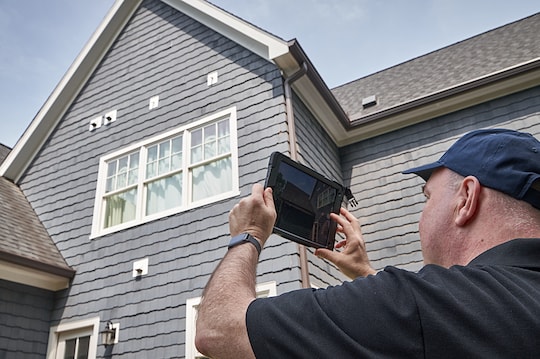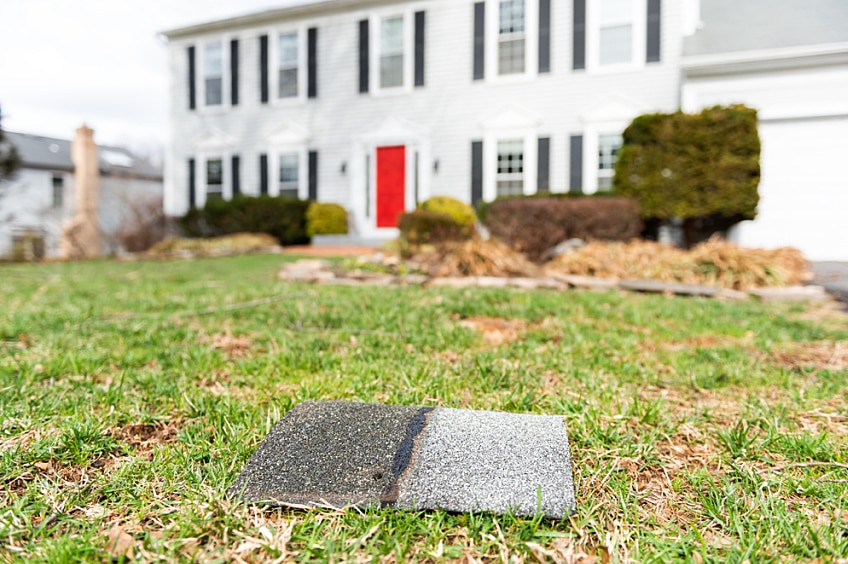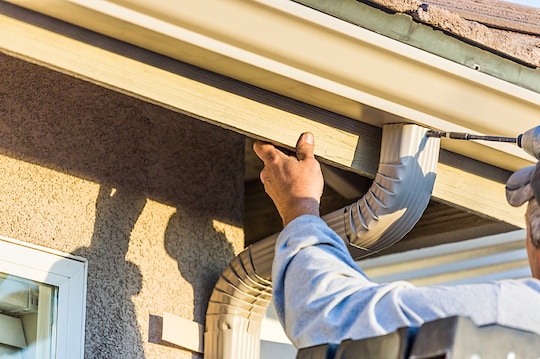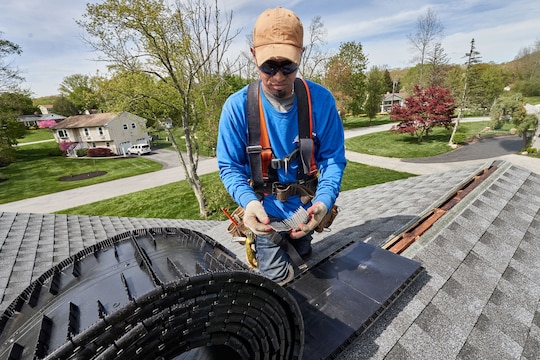
Upcoming roofing project? Prepare like a pro using this checklist to ensure that every detail is in order before the roofers start work.
Read on to learn more about how to plan for a new roof and what steps to take to make sure the interior and exterior of your home are protected during the project, plus topics to discuss with your contractor before and after to make sure the project goes off without a hitch.
Schedule Tasks in Advance
After you choose a roofing contractor, determine if work permits are required for your roofing project. Then, clarify if you or the contractor will obtain them. Put the permit process in motion right away so that there are no delays in your project timing.
It's also important to schedule the removal and replacement of items such as satellite dishes and solar panels in advance so the service providers can coordinate these tasks around the timing of your roof project.
Prepare Your Home
Roofing is a job best left to the pros. However, minor participation on your part will make the process easier on you, your home, and your contractor. Here's how to prepare:
Connect With Your Contractor
At some point prior to work starting, your roofing contractor will need to know job site details. Be prepared to:
Walk the perimeter of the house and point out areas for roofers to protect or avoid.
Point out electrical outlets roofers can use for their power tools. If there are no available outdoor outlets, arrange for roofers to access power via an extension cord through an open window or door to your home or garage.
Discuss what date the materials and dumpster (if required) will be dropped off and where it is safe to do so.
Discuss HOA guidelines (if applicable) on construction start and stop times.
- Verify how additions to your rooftop—such as satellite dishes and solar panels—need to be managed and time frames for having them removed.
Once materials have been delivered, verify that you received the correct shingle color, brand, quality, etc.
Contractor Checklist
The roofers perform prep work to ensure your roofing project goes well. Here are some "checklist items" they should be completing. Speak to your contractor if these don't occur:
Confirmation of project start date and time frame
A system to funnel debris from roof into dumpster
Placement of tarps to protect the driveway and landscaping
Protection of exterior AC unit
Protection of deck and patio areas
For Your Home's Exterior
Roofing involves a roofing crew, roofing materials, roof debris, and—very often—an onsite dumpster. It's messy work, but the more you cover, clean, and protect, the more seamless the outcome will be. Here are some actionable steps to take as a homeowner:
Protect outdoor lighting, water features, yard art, bird houses, etc. from falling roof debris that could damage delicate items.
Move patio furniture, barbecue grills, and children's toys away from the roof perimeter.
Take down flags, wind chimes, and other exterior home decorations.
Mow the lawn. This increases visibility of roofing debris that falls in your yard and makes for a more thorough cleanup from roofers.
Mark sprinkler heads with orange tape or flags so that roofers don't trip over them or damage your sprinkler system. Visibility benefits everyone!
Take photos of your driveway and exterior in case of damage by roofing work or the dumpster.
Cover flower beds and landscaping to keep roofing debris out and move potted plants. Mark especially delicate or expensive landscaping and notify roofers to take extra care around these areas.
Move cars, bikes, etc. from inside the garage if the dumpster or roofing materials will block access to items you'll need.
- Walk the perimeter of your home with your contractor. Make them aware of any exterior areas that may be more delicate than others.
For Your Home's Interior
While your roofers are working hard, walls vibrate and loud noises occur. Preventative measures keep everyone comfortable:
Temporarily move and/or cover valuable items stored in the attic.
Put a drop cloth on the attic floor for a quick dust clean up. You can expect dust and debris to shake down onto the attic floor.
Remove or secure TVs, mirrors, china cabinets, artwork, and other valuables attached to walls.
Plan ahead for loud noises:
If you work from home, consider alternative arrangements.
Prepare to soothe pets and make daycare arrangements if your pet is sensitive to noises.
Prepare kids for disruptive and loud noises—it might be a good time for the kids to visit friends or family.
If staying offsite, be sure you remain in easy contact with the roofer in case of questions.
Cover and protect valuables (cars, storage, etc.) in the garage. The lack of insulation in most garages increases the amount of dust and debris that falls in the garage during the roofing project.
The Day Before (or Early Morning Of)
Roofers start early, so be ready before they come. Take these final steps the night before if you're a late riser:
Move your cars to the street for easy worker access.
Keep any and all pets indoors. Or, if necessary, move pets and/or family to a pre-arranged location.
Unlock or arrange for access to gates or other obstacles to the home's perimeter.
After the Project
Once the roofing project is complete and contractor cleanup has occurred, make sure you're satisfied with the job and that you have all the necessary paperwork for your warranty. These follow-up steps can help you enjoy your investment for years to come:
Final Inspections
- Visually inspect your lawn, landscaping, gutters, and patios. Ensure all debris has been removed. If you spot a loose nail or two in the grass, that may mean more are lurking unseen. You can request for roofers to return for another magnetized sweep (to catch fallen nails) and debris removal, if necessary.
- Inspect your driveway for debris and possible damage from the dumpster or roofing materials.
- Use binoculars or ask the contractor if they use a drone to take photos to view the roof. Note questions—if any—to ask your contractor.
- Arrange a walk-through with the contractor to finalize the job. Ask all your questions, point out damage (if applicable), request additional cleanup services if loose nails or debris still linger, and have them walk you around your home while providing a description of work performed.
- Contact providers about reinstallation of satellite dishes or solar panels, as needed.
- Pay the roofing company or roofing contractor in a timely fashion.
Warranty Documenting
A little bit of paperwork goes a long way toward protecting your home investment. Obtain copies of these documents so that if roof warranty or insurance claims arise, you're ready:
- Copy of the building permit for roof work (if applicable)
- Copy of the work contract with your roofing company, as well as any warranty or coverage provided under the contractor's insurance policy.
- Copy of manufacturer warranties for roof materials or roof system if applicable. Carefully read warranties right away so you understand terms and don't accidentally void warranties (by doing an unauthorized DIY roof repair, for example).
Ready to get started on your new roofing project? Find a residential roofing contractor certified by GAF* near you.
*Contractors enrolled in GAF certification programs are not employees or agents of GAF, and GAF does not control or otherwise supervise these independent businesses. Contractors may have agreed that they will use GAF roofing products, and may receive benefits, such as loyalty rewards points and discounts on marketing tools from GAF for participating in the program.



